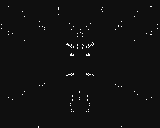

McPepic 2023-02-08 02:36
This uses @SP4CEBAR's 3D object viewer program and @nathanielbabiak's formatting to fit object files in LowRes.
I wanted to make my own converter to upload any object file.
The converter can be found here: https://github.com/McPepic/OBJ-to-NX
:)


GAMELEGEND 2023-02-08 04:46
Okay that is just cool!
nathanielbabiak 2023-02-08 06:16
Very cool - you can actually see it!
But, that's actually my 3D viewer, rather than SP4CEBAR's. (I'm a little confused?
The upload even shows my by-line at the top of the source code?) There's no code common to both viewers, I just wrote a point-cloud renderer from scratch...
McPepic 2023-02-08 16:09
@nathanielbabiak
I realize that I used your 3D viewer, I just wanted to credit you both for your work on getting 3D working in LowRes from an object file.
nathanielbabiak 2023-02-08 20:19
Sounds good.
Also, wanted to mention you'll get better results if you shuffle the order of points within the point cloud, and you don't need to save the faces to the file either (all of the 128 kb upload can be for point data, with none for face data).
Not that those things matter too much here, since the upload is only 30 kB, but you never know
GAMELEGEND 2023-02-08 22:20
So there is a string called V$ and another called F$
how do you know what should go in each string?
McPepic 2023-02-08 23:22
@GAMELEGEND
V$ stores the vertex data in hexadecimal. Every 4 characters is a fixed-point number between -4 and ~4. Each number is stored as part of an x,y,z set of data that describes the 3D position of a vertex.
F$ is the face/triangle data. It stores 3 16-bit integers (shorts), which are the indices of the vertices that make up that triangle.
You can use your own object files (.obj) using my tool that I linked to in the description and following the directions on the GitHub page! :)